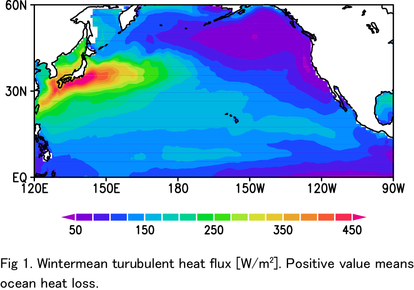Elucidation of mechanisms for sea-surface temperature variability and its role in surface turbulent heat flux variability in the Kuroshio-Oyashio mixed water region
| A03-K6. Elucidation of mechanisms for sea-surface temperature variability and its role in surface turbulent heat flux variability in the Kuroshio-Oyashio mixed water region | |
|---|---|
| PI | Shusaku SUGIMOTO*(Assistant Professor, Tohoku University) |
[Doctral degree: *Oceanography]
The Kuroshio/Kuroshio-Oyashio Confluence (KOC) region is characterized by vigorous heat release related to turbulent heat flux (THF; sum of sensible and latent heat fluxes) from the ocean to atmosphere during winter (Fig. 1) and one of extremely large THF-release regions in the world’s oceans. To date, numerous authors have shown their interest in variable THF, and they have reported that the heat flux exchanges between the ocean and atmosphere over the KOC region affect vigorous atmospheric phenomena such as storm-track activity and cloud distributions.
The previous statistical studies have presented that the wind-induced THF negatively correlated with sea surface temperature (SST) anomalies over the extratropical North Pacific; colder SST is attributed to the oceanic heat releases. However, a few authors showed positive correlations between wintertime SST and heat fluxes in the KOC region; more active upward heat fluxes on the warmer SST area.
We attempt to reveal the relationship between the ocean and atmosphere over the KOC region, by using the observed dataset and hindcast model outputs, following the below three targets.
1st target: Reconsideration of the positively correlated relations between the upward THF and SST in the KOC region, using the daily flux dataset. We attempt to assess quantitatively which parameters–that is, SST, surface air temperature, and wind speed–contribute in determining THF, by applying a simple experiment; two types of datasets are prepared for bulk parameters. One is raw daily data and the other is daily climatological data. Then, we describe a role of SST in determining the THF in the KOC region.
2nd target: Understating of mechanisms inducing SST variations in the KOC region by using satellite-derived datasets of SST and sea surface height (SSH) with high spatial and temporal resolutions.
Figure 2 displays snapshots of SSH and SST anomaly field in January 20, 1999. Within the KOC region, anticyclonic eddies with positive SST anomalies are observed; that is, warm eddies. It is expected that the SST is formed through the warm eddies. We investigate relationships between the warm eddies and SST variations in the KOC region.
3rd target: Based on the above results, we attempt to obtain a scenario of air-sea coupled system in the KOC region.



